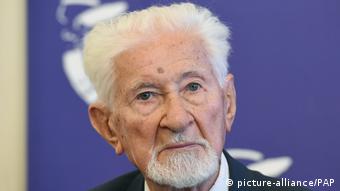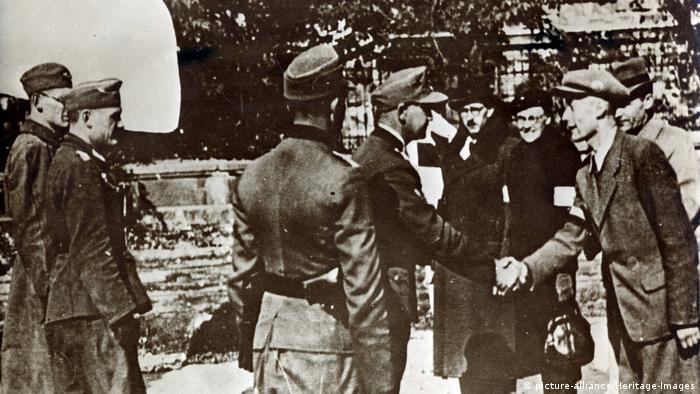75 years ago in Warsaw rose up against the German occupation. Every 1. August reminds Poland of the victims of the Warsaw uprising. At this year’s commemoration also Federal part, foreign Minister Heiko Maas.

Soldiers of the Polish home army are holed up in a ruined house, in front of German troops
Rarely, German politicians have visited on the anniversary of the Warsaw uprising, the Polish capital. 25 years ago, traveled to the former German Federal President Roman Herzog; he asked in front of the monument for the victims of the uprising’s forgiveness. Only ten years later, in 2004, visited with Gerhard Schröder, the SPD Chancellor in Warsaw. “We bow to our troops in shame in the face of the crimes of the Nazi,” he said at the time, and spoke of “German shame”.
Dark Chapter of German-Polish history
No other event has in the self-understanding of the Polish capital, imprinted, such as the uprising of 1. August 1944. This is mostly due to the high number of casualties, because the Germans crushed the uprising with particular brutality. Up to 200,000 people, mainly civilians, have been partially killed in mass executions – nearly one-third of them from the start. Hundreds of thousands were deported, among other things, to forced labour, mostly in concentration camps. To date, the Warsaw uprising casts a shadow over the German-Polish relationship.

August, 1994: German President Roman Herzog lays a wreath in front of the memorial for the victims of the Warsaw uprising
The more positive this year, the participation of the German acting Minister of foreign Affairs at the commemoration ceremony. While the Polish government party, the PiS, the demands for German war reparations for the Second world war are getting louder and louder, invited the Polish foreign Minister to his counterpart, Heiko Maas of the 75-year-old memorial a celebration. In the case of the reparation demands of the National-Conservative and the destruction of Warsaw plays the Central role. The former mayor and later President of Poland, Lech Kaczynski, left, in 2004, the damage of the city on a $ 45 billion charge.
Foreign Minister Maas praised already before the actual day of remembrance of the resistance and the courage, with the Poland of 1944, the German occupation, contrary to have. This witness of an overwhelming desire for freedom and self-determination. “Poland and Warsaw in particular has managed the reconstruction after the war, on its own, I feel a great respect and deep humility.”
Terror against Polish resistance
The destruction of the city was preceded by five years of brutal repression by the German occupying forces. Deportations, group executions, and persecutions were on the agenda. After in the spring of 1943, the uprising of the Jewish population in the Warsaw Ghetto, brutally beaten, had been (both uprisings are often confused), the Terror in the city.
As on 1. August 1944 the Warsaw uprising broke out, lived in the city almost a Million people. 40,000 of them were volunteer soldiers of the underground army, which was led by the Polish government-in-exile from London. You 16.000 soldiers of the Wehrmacht and the SS were the first special commands, which were quickly reinforced.

The Veterean Leszek Zukowski
At this time, the Wehrmacht on the retreat from the East, the Soviet Red army advanced ever closer. “The Germans plan to make Warsaw a fortress, which it was clear that the city would have been completely destroyed,” recently said Leszek Zukowski, Chairman of the largest Polish veterans organization at the opening of an exhibition about the Warsaw uprising in Berlin. “We wanted to release the stop, and the city itself,” said Zukowski, the fight at the age of 15 in the underground army.
However, the Germans, the uprising came to be located. It was “a blessing that the poles make it”, reported at the time of the SS-Reichsführer Heinrich Himmler, who was instrumental for the atrocities in Poland. “My leader,” he said in the late summer of 1944 the dictator, Adolf Hitler directed, “about five, six weeks we come. But then Warsaw, the capital, the head is wiped, the intelligence of this former 16-17 million people of Poland”. Already in the first days of the uprising, the Nazis executed around 50,000 civilians.
The lonely fight of the insurgents
The rebels are hoping for help from the outside. However, the supply of weapons, ammunition and food for the soldiers of the Western allies with parachutes, missed often the goal. And the Red army is not stopped on the other Bank of the Vistula, and handle. Stalin had no interest in helping the Polish home army, the anti-Communist government in exile was led. After 63 days the insurgents had to surrender.

Representatives of the Polish home army surrendered to the German occupiers
Then Warsaw was destroyed on personal order of Adolf Hitler to a large extent. 90 percent of all historic buildings, including the Royal castle, were blown up; as all the bridges and industrial buildings. In the autumn of 1944, a few thousand people survived in the rubble of the town centre just once.
In the Silence, to remember together
What happened in 1944 in Warsaw, was concealed for decades by the Communist Regime. Only in 1989, a public discussion began. Even if, as before, to the heroism of the insurgents is in the foreground, is now also the high death toll in question.

Gerhard Schröder was the first Chancellor who took part in the day of remembrance for the Warsaw uprising
Today, hundreds of commemorative plaques in the town to the battles of 1944. In the wall of the St. John Cathedral in the old town, where a defensive Outpost of the insurgents was located, is walled in a chain. The Nazis had brought in the Church, a remote-controlled and explosives-Laden tank, to the Explosion.
Another special place of remembrance opened in 2004, the Museum of the Warsaw uprising. On 1 want. August, the German foreign Minister to deliver his speech flies in the afternoon back to Germany. Just in time to 17 o’clock, the sirens howling in Warsaw. People remain, the cars stop – the Polish capital frozen in a moment of silence.